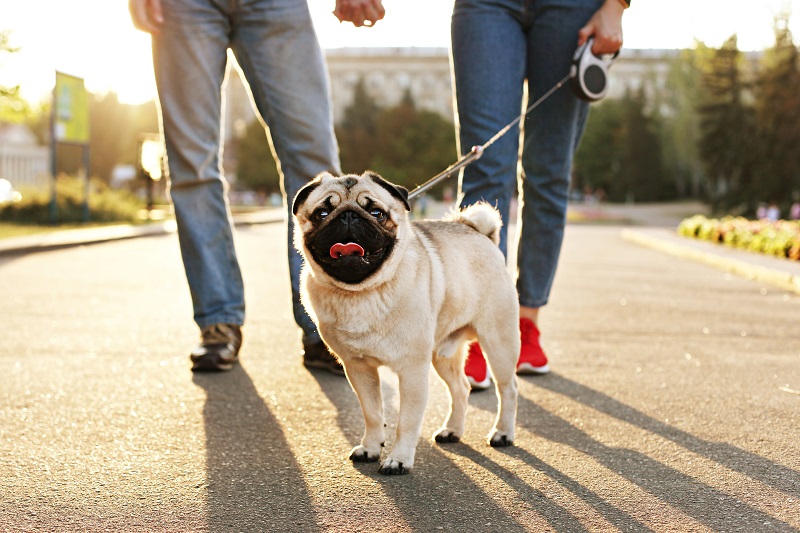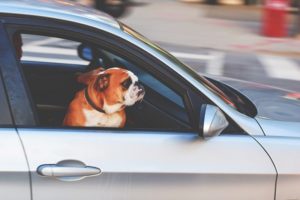
For some pet owners, summer means taking advantage of warm weather and enjoying the local outdoors with their furry friend. Others take advantage of summer’s relaxed schedule by going on a road trip with their pet. Whether you have fun in the sun near your home or head out for an adventure, our summer safety tips will ensure you and your furry companion don’t run into danger.
Preventing Heatstroke in Your Pet
Heatstroke is a common summertime emergency, and occurs when a pet’s body temperature rises above 102 degrees. Heatstroke is a dangerous situation, and can be deadly if not recognized and corrected immediately. Common scenarios that lead to heatstroke include:
Many owners assume that if they can take the heat, their pets can also, but this is often untrue. Pets cannot cool themselves as well as people, because they have only a few sweat glands on their feet, and they rely on evaporation from their mouth surfaces as they pant. Since they also have a thick hair coat, pets are often hot long before their two-legged companions start to feel uncomfortable.
Any animal can overheat, but some pets are more likely to develop heatstroke. Brachycephalic breeds with short muzzles, such as bulldogs and pugs, are less efficient at cooling, because their shorter faces offer less surface area for evaporation. Pets who are older or overweight, or who have a chronic disease condition, are also at higher heatstroke risk. Owners should carefully monitor these pets on hot days, and restrict their time outdoors to short bathroom breaks.
Pets with heatstroke can quickly begin acting abnormally, and will display signs that may include:
If you think your pet may have heatstroke, take him inside to a cool place and offer him a drink of water. Place cool, wet towels over his body, but never submerge him in water or use cold water to bring his temperature down, as rapid temperature changes can cause his blood pressure to suddenly drop. If your pet does not improve in 10 minutes or is unresponsive, take him to a veterinarian immediately. Your primary care veterinarian can likely handle most heatstroke cases, but severe cases may require specialized care or 24-hour monitoring at our emergency facility.
To prevent heatstroke, follow these tips to keep your pet cool and comfortable:
Planning for a Summer Road Trip with Your Pet
If you are planning a road trip this summer, why not take your furry friend along? Hitting the open road together can be a great bonding experience, and some preparation will ensure a smooth ride.

Some dogs love car trips, while others find the car intimidating, especially if their only rides have been to the vet’s office or the groomer. Start preparing for your upcoming trip several weeks ahead by taking your dog on short car rides to places he will enjoy, such as the park or pet store. Make the trip a positive experience by rewarding him with lots of attention, and a favorite treat when you return home. As your pet becomes more comfortable, increase the length of your rides. If your pet is highly anxious during rides or if he vomits, speak with your veterinarian about medications that could help him relax.
Anxious pets often feel more relaxed if they are not given free rein in the car, and a dog unexpectedly jumping in your lap can cause an accident, so always use a sturdy crate or seat harness to keep your pet safely restrained. A crate provides a safe place for a small pet to curl up and sleep comfortably, while bigger dogs may enjoy looking out the window from the passenger seat while safely harnessed. Never allow your dog to ride with his head hanging out of the window—his face or eyes can be hit by flying debris, or he could try to jump out, with disastrous results.
As you pack your bags, don’t forget to also pack your pet’s necessities, including:
You may be able to ride for hours without stopping, but your pet will need a break every hour or so. Always attach a leash before taking your pet out of the car to keep him safely by your side and to prevent him from escaping in unfamiliar territory. Walk him around a grassy space, if possible, for a bathroom break and offer water to keep him hydrated.
Whether you choose to enjoy the great outdoors close to your home or you decide to travel, including your pet can make your summer more enjoyable. If you have questions about how to safely include your pet in your summer plans, contact us or your family veterinarian.